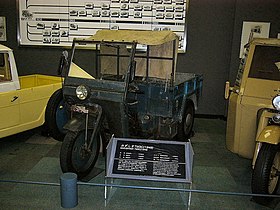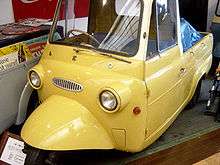Mitsubishi Mizushima
The Mitsubishi Mizushima (Japanese: 三菱・みずしま) is the first of a series of three-wheeled cargo carriers made in Japan by Mitsubishi between 1947 and 1962.[1] A number of prototypes were built in 1946, leading to series production beginning in May 1947. Along with the Silver Pigeon scooter it represented the company's first contributions to the Japanese post-war personal transport boom.[2]
| Mitsubishi Mizushima | |
|---|---|
 Mitsubishi Mizushima TM3C | |
| Overview | |
| Manufacturer | Mitsubishi |
| Production | 1947–1962 |
Mizushima Works
The Mizushima Aircraft works was originally established in September 1943 to build the Mitsubishi G4M2 (504 examples) and later the N1K2-J Shiden-Kai (7 planes completed). The factory was built on mostly virgin land, and the township of Mizushima, Kurashiki was established around the plant.[3] The factory was heavily damaged in a 22 June 1945 B-29 bombing raid and no more planes were produced.[4] In November 1945, the Occupying Forces were petitioned to allow the company to be reorganized for peacetime activities, and Mizushima Engineering Works was born. Originally part of Mitsubishi Heavy Industries, the zaibatsu was broken up into three separate companies in January 1950, with Mizushima becoming part of Central Japan Heavy-Industries, Ltd. This company was renamed Shin-Mitsubishi Heavy Industries in May 1952, as the occupation ended and the Mitsubishi name was once again allowed to be used.[5] The Mizushima factory changed name again in October 1960, becoming the "Mizushima Motor Works."[6]
TM3
The Mizushima XTM-1 prototype was completed in 1946.[7] The original production version (TM3A) appeared the following year and was a mechanically simple and rugged vehicle, with a 400 kg carrying capacity.[8] Unlike most three-wheeled trucks in the market, however, the TM3A was equipped with a folding canvas covering and a windshield to protect the occupants.
Evolutions
Later models would be introduced offering greater load-bearing abilities and a wider variety of bodystyles.[8] The 1948–50 TM3D model was built with a hardtop passenger cabin in response to customer demands, while the final development of the Mizushima line, the TM18 Mitsubishi 1500 pickup introduced in 1955,[9] could carry up to two tons in its cargo bed. The first models had air-cooled single-cylinder engines, but with the 1955 TM7 a 1.3-liter OHV twin-cylinder engine with 36 PS (26 kW) appeared. This engine type diverged into a 1145 and a 1489 cc version in 1958, to help cover weight classes ranging from one to two tonnes (2,200 to 4,400 lb).
During the Mizushima's life approximately 91,000 were produced, before it was replaced by the Mitsubishi Minicab and various other four-wheeled light- and medium-duty trucks in 1962.[8][10]
Mizushima models
| Model | Engine | Power | Trans- mission |
Top Speed | Payload | Weight | Length | Width | Wheelbase | Cargo bed length | Years produced |
Notes | |||||||||||
|---|---|---|---|---|---|---|---|---|---|---|---|---|---|---|---|---|---|---|---|---|---|---|---|
| Layout | Type | PS | kW | at (rpm) | km/h | mph | kg | lb | kg | lb | mm | in | mm | in | mm | in | mm | 尺 | in | ||||
| TM3A | 744 cc air-cooled SV single | 3A | 13.5 | 10 | 3000 | 3MT | 50 | 31 | 400 | 882 | 585 | 1,290 | 2,797 | 110 | 1,750 | 69 | 1,880 | 74 | 1947-1954 | TM3C/F capacity 500kg | |||
| TM4E | 886 cc air-cooled SV single | ME10 | 20.5 | 15 | 3400 | 55 | 34 | 1,000 | 2,205 | 780 | 1,720 | 3,610 | 142 | 1,452 | 57 | 2,360 | 93 | 1,950 | 6.43 | 76.8 | 1952-1956? | width later 1550mm | |
| TM4F | 1,000 | 2,205 | 3,810 | 150 | 1,452 | 57 | 2,460 | 97 | 2,150 | 7.10 | 84.6 | 1954-1956? | |||||||||||
| TM5F | 1,000 | 2,205 | 875 | 1,929 | 3,810 | 150 | 1,550 | 61 | 2,460 | 97 | 2,150 | 7.10 | 84.6 | 1955-195? | |||||||||
| TM5G | 1,000 | 2,205 | 920 | 2,028 | 4,210 | 166 | 1,550 | 61 | 2,575 | 101 | 2,550 | 8.41 | 100 | 1955-195? | |||||||||
| TM6 | 744 cc air-cooled SV single | 6A | 15 | 11 | 3400 | 750 | 1,653 | 3,360 | 132 | 1,452 | 57 | 2,120 | 83 | 1955-195? | |||||||||
| TM7A | 1276 cc air-cooled OHV twin | ME7 | 36 | 26.5 | 3600 | 4MT | 74/78 | 46/48.5 | 1,500 | 3,307 | 1,235 | 2,723 | 4,500 | 177 | 1,680 | 66 | 3,000 | 118 | 2,500 | 8.25 | 98.4 | 1955-195? | steering wheel |
| TM8B | 72/76 | 45/47 | 2,000 | 4,409 | 1,310 | 2,888 | 5,100 | 201 | 1,680 | 66 | 3,300 | 130 | 3,100 | 10.2 | 122 | 1955-195? | TM8A is shorter; dimensions as per TM7A | ||||||
| TM11F | 886 cc air-cooled SV single | ME10 | 20.5 | 15 | 3400 | 3MT | 55 | 34 | 1,000 | 2,205 | 867 | 1,911 | 3,790 | 149 | 1,550 | 61 | 2,465 | 97 | 2,150 | 7.10 | 84.6 | 1956-195? | |
| TM11G | 1,000 | 2,205 | 891 | 1,964 | 4,180 | 165 | 1,550 | 61 | 2,535 | 100 | 2,550 | 8.41 | 100 | ||||||||||
| TM12F | 851 cc air-cooled OHV single | ME12 | 27 | 20 | 3600 | 4MT | 74 | 46 | 1,000 | 2,205 | 900 | 1,984 | 3,940 | 155 | 1,550 | 61 | 2,575 | 101 | 2,150 | 7.10 | 84.6 | 1957-195? | |
| TM14G | 72 | 45 | 1,250 | 2,756 | 925 | 2,039 | 4,290 | 169 | 1,550 | 61 | 2,700 | 106 | 2,550 | 8.41 | 100 | 1957-195? | Also shorter TM14F; dimensions as per TM12F | ||||||
| TM15 | 1145 cc air-cooled OHV twin | ME15 | 36 | 26.5 | 78 | 48.5 | 1,000 | 2,205 | 980 | 2,161 | 4,130 | 163 | 1,640 | 65 | 2,765 | 109 | 2,150 | 7.10 | 84.6 | 1958-1962 | |||
| TM16 | 1,250 | 2,756 | 1,010 | 2,227 | 4,480 | 176 | 1,640 | 65 | 2,890 | 114 | 2,500 | 8.25 | 98.4 | ||||||||||
| TM17 | 1489 cc air-cooled OHV twin | ME18 | 47 | 34.5 | 80 | 50 | 1,500 | 3,307 | 1,160 | 2,557 | 4,510 | 178 | 1,690 | 67 | 3,050 | 120 | 2,500 | 8.25 | 98.4 | ||||
| TM18 | 2,000 | 4,409 | 1,230 | 2,712 | 5,110 | 201 | 1,690 | 67 | 3,350 | 132 | 3,100 | 10.2 | 122 | ||||||||||
Leo

The 1959 Mitsubishi Leo, heavily influenced by the Mizushima, was a transition between the company's first post-war vehicles and the Mitsubishi Minica, which represented the company's future in the 1960s. The Leo used a 309 cc air-cooled single-cylinder engine, the ME20, producing 12.5 hp at 4,500 rpm. Payload was 300 kg (660 lb), top speed 65 km/h (40 mph).[11]
Almost four decades later, Olivier Boulay would borrow heavily from the Leo for styling cues for his first prototypes when he became Mitsubishi Motors' design chief in 2001.[12]
References
- "1941–1950 Reconstruction, Recovery and Hope". Mitsubishi Motors South Africa. Archived from the original on 2007-08-19.
- "Rebuilding the Nation". Mitsubishi Motors History. Mitsubishi Motors South Africa. Archived from the original on 2007-08-23.
- "倉敷(水島)航空基地跡地" [Site of Kurashiki (Mizushima) Air Base]. 空港探索 [Airport Exploration] (in Japanese). Archived from the original on 2020-07-06.
- Miura, Hiroshi (2015-06-04). "戦後70年 水島空襲の記憶たどる" [Tracing memories of the Mizushima air raid, 70 years after the war]. The Asahi Shimbun (in Japanese). Archived from the original on 2015-06-04.
- Toma, Setsuo (2019-08-27). "「モーターファン」誌1952年1月号に載った広告" [Advertising in the January 1952 issue of "Motorfan" magazine]. M-Base (in Japanese). Miki Press. Archived from the original on 2019-12-19.
- "三菱重工業株式會社 水島航空機製作所(第七製作所)・龜集團 疎開工場" [Mitsubishi Heavy Industries Ltd. Mizushima Aircraft Factory (No. 7 Factory), Ganshudan Evacuation Factory]. 大日本者神國也 (in Japanese). 2013-09-14. Archived from the original on 2019-02-26.
- 空力特性と基本重視の高性能車を開発 [Developed a high-performance vehicle which emphasizes basic aerodynamic characteristics] (PDF) (in Japanese), JAHFA (Japan Automotive Hall of Fame), January 2009, p. 1, archived from the original (PDF) on 2020-07-06
- "Mizushima". Mitsubishi Motors South Africa website. Archived from the original on 2007-09-28.
- "1940–1959". Mitsubishi Motors Web Museum. Archived from the original on 2012-01-30.
- 路畑寺夜村 (1994-10-01). "三菱号三輪トラックTM14G「みずしま」が生んだ単気筒小型トラックの絶巓" [The single-cylinder small three-wheeled TM14G "Mizushima" mountain truck produced by Mitsubishi]. Old-timer (in Japanese). Vol. 4 no. 5, 18. YAESU Publishing co.ltd. [八重洲出版]. p. 38.
- 360cc 軽商用貨物自動車 1950-1975 [360cc: Light Commercial Truck 1950-1975] (in Japanese). Tokyo: Yaesu Publishing. 2009. pp. 10–11, 83. ISBN 978-4-86144-139-4.
- Dawson, Chester (November 5, 2001). "Mitsubishi Gets a Makeover". BusinessWeek. Archived from the original on 2004-06-07.